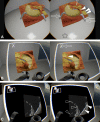High-Performance Virtual Reality Volume Rendering of Original Optical Coherence Tomography Point-Cloud Data Enhanced With Real-Time Ray Casting
- PMID: 30002949
- PMCID: PMC6038772
- DOI: 10.1167/tvst.7.4.2
High-Performance Virtual Reality Volume Rendering of Original Optical Coherence Tomography Point-Cloud Data Enhanced With Real-Time Ray Casting
Abstract
Purpose: Feasibility testing of a novel volume renders technology to display optical coherence tomography data (OCT) in a virtual reality (VR) environment.
Methods: A VR program was written in C++/OpenGL to import and display volumetric OCT data in real time with 180 frames per second using a high-end computer and a tethered head-mounted display. Following exposure, participants completed a Simulator Sickness Questionnaire (SSQ) to assess for nausea, disorientation, and oculomotor disturbances. A user evaluation study of this software was conducted to explore the potential utility of this application.
Results: Fifty-seven subjects completed the user testing (34 males and 23 females). Mean age was 48.5 years (range, 21-77 years). Mean acquired work experience of the 35 ophthalmologists (61.40%) included in the group was 15.46 years (range, 1-37 years). Twenty-nine participants were VR-naïve. The SSQ showed a mean total score of 5.8 (SD = 9.44) indicating that the system was well tolerated and produced minimal side effects. No difference was reported between VR-naïve participants and experienced users. Overall, immersed subjects reported an enjoyable VR-OCT presence effect.
Conclusions: A usable and satisfying VR imaging technique was developed to display and interact with original OCT data.
Translational relevance: An advanced high-end VR image display method was successfully developed to provide new views and interactions in an ultra high-speed projected digital scenery using point-cloud OCT data. This represents the next generation of OCT image display technology and a new tool for patient engagement, medical education, professional training, and telecommunications.
Keywords: mesh; ophthalmology; optical coherence tomography; point cloud data; polygon; ray casting; virtual reality; volume rendering.
Figures



References
-
- Want JPM-W M. What does virtual reality NEED?: human factors issues in the design of three-dimensional computer environments. Int J Hum Comput Stud. 1996;44:829–847.
-
- Mirghani I, Mushtaq F, Allsop MJ, et al. Capturing differences in dental training using a virtual reality simulator. Eur J Dent Educ. 2018;22:67–71. - PubMed
-
- Larsen CR, Oestergaard J, Ottesen BS, Soerensen JL. The efficacy of virtual reality simulation training in laparoscopy: a systematic review of randomized trials. Acta Obste Gynecol Scand. 2012;91(9):1015–1028. - PubMed
LinkOut - more resources
Full Text Sources
Other Literature Sources

